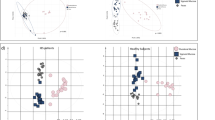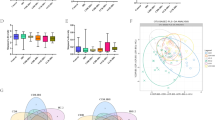Abstract
Background
Dysbiosis may play a role in irritable bowel syndrome (IBS), hitherto an enigmatic disorder. We evaluated selected fecal microbes in IBS patients and healthy controls (HC).
Methods
Fecal 16S rRNA copy number of selected bacteria was studied using qPCR in 47 patients with IBS (Rome III) and 30 HC.
Results
Of 47 patients, 20 had constipation (IBS-C), 20 diarrhea (IBS-D), and seven unclassified IBS (IBS-U). Relative difference in 16S rRNA copy number of Bifidobacterium (P = 0.042) was lower, while those of Ruminococcus productus-Clostridium coccoides (P = 0.016), Veillonella (P = 0.008), Bacteroides thetaiotamicron (P < 0.001), Pseudomonas aeruginosa (P < 0.001), and Gram-negative bacteria (GNB, P = 0.001) were higher among IBS patients than HC. Number of Lactobacillus (P = 0.002) was lower, while that of Bacteroides thetaiotamicron (P < 0.001) and segmented filamentous bacteria (SFB, P < 0.001) was higher among IBS-D than IBS-C. Numbers of Bacteroides thetaiotamicron (P < 0.001), P. aeruginosa (P < 0.001), and GNB (P < 0.01) were higher among IBS-C and IBS-D than HC. Quantity of SFB was higher among IBS-D (P = 0.011) and lower among IBS-C (P = 0.002) than HC. Number of Veillonella species was higher among IBS-C than HC (P = 0.002). P. aeruginosa was frequently detected among IBS than HC (46/47 [97.9 %] vs. 10/30 [33.3 %], P < 0.001). Abdominal distension (n = 34/47) was associated with higher number of Bacteroides thetaiotamicron, Clostridium coccoides, P. aeruginosa, SFB, and GNB; bloating (n = 22/47) was associated with Clostridium coccoides and GNB. Microbial flora was different among IBS than HC on principal component analysis.
Conclusion
Fecal microbiota was different among IBS than HC, and different sub-types were associated with different microbiota. P. aeruginosa was more frequent and higher in number among IBS patients.


Similar content being viewed by others
References
Longstreth GF, Thompson WG, Chey WD, Houghton LA, Mearin F, Spiller RC. Functional bowel disorders. Gastroenterology. 2006;130:1480–1491.
Malinen E, Krogius-Kurikka L, Lyra A, et al. Association of symptoms with gastrointestinal microbiota in irritable bowel syndrome. World J Gastroenterol. 2010;16:4532–4540.
Parkes GC, Brostoff J, Whelan K, Sanderson JD. Gastrointestinal microbiota in irritable bowel syndrome: their role in its pathogenesis and treatment. Am J Gastroenterol. 2008;103:1557–1567.
Ohman L, Simren M. New insights into the pathogenesis and pathophysiology of irritable bowel syndrome. Dig Liver Dis. 2007;39:201–215.
Pimentel M, Lembo A, Chey WD, et al. Rifaximin therapy for patients with irritable bowel syndrome without constipation. N Engl J Med. 2011;364:22–32.
Guandalini S, Magazzu G, Chiaro A, et al. Vsl#3 improves symptoms in children with irritable bowel syndrome: a multicenter, randomized, placebo-controlled, double-blind, crossover study. J Pediatr Gastroenterol Nutr. 2010;51:24–30.
Silk DB, Davis A, Vulevic J, Tzortzis G, Gibson GR. Clinical trial: the effects of a trans-galactooligosaccharide prebiotic on faecal microbiota and symptoms in irritable bowel syndrome. Aliment Pharmacol Ther. 2009;29:508–518.
Malinen E, Rinttila T, Kajander K, et al. Analysis of the fecal microbiota of irritable bowel syndrome patients and healthy controls with real-time pcr. Am J Gastroenterol. 2005;100:373–382.
Lee BJ, Bak YT. Irritable bowel syndrome, gut microbiota and probiotics. J Neurogastroenterol Motil. 2011;17:252–266.
Kerckhoffs AP, Ben-Amor K, Samsom M, et al. Molecular analysis of faecal and duodenal samples reveals significantly higher prevalence and numbers of pseudomonas aeruginosa in irritable bowel syndrome. J Med Microbiol. 2011;60:236–245.
Sung J, Morales W, Kim G, et al. Effect of repeated campylobacter jejuni infection on gut flora and mucosal defense in a rat model of post infectious functional and microbial bowel changes. Neurogastroenterol Motil. 2013;25:529–537.
Balsari A, Ceccarelli A, Dubini F, Fesce E, Poli G. The fecal microbial population in the irritable bowel syndrome. Microbiologica. 1982;5:185–194.
Liebregts T, Adam B, Bredack C, et al. Immune activation in patients with irritable bowel syndrome. Gastroenterology. 2007;132:913–920.
Barbara G, Cremon C, Carini G, et al. The immune system in irritable bowel syndrome. J Neurogastroenterol Motil. 2011;17:349–359.
Loh G, Blaut M. Role of commensal gut bacteria in inflammatory bowel diseases. Gut Microbes. 2012;3:544–555.
Bellavia M, Damiano G, Gioviale MC, et al. Abnormal expansion of segmented filamentous bacteria in the gut: a role in pathogenesis of chronic inflammatory intestinal diseases? Rev Med Microbiol. 2011;22:45–47.
Hattori T, Fukudo S. Use of Rome III criteria for diagnosing irritable bowel syndrome. Nihon Rinsho. 2006;64:1425–1428.
Ghoshal UC, Gwee KA, Chen M, et al. Development, translation and validation of enhanced asian rome iii questionnaires for diagnosis of functional bowel diseases in major asian languages: a Rome foundation-asian neurogastroenterology and motility association working team report. J Neurogastroenterol Motil. 2015;21:83–92.
Bartosch S, Fite A, Macfarlane GT, McMurdo ME. Characterization of bacterial communities in feces from healthy elderly volunteers and hospitalized elderly patients by using real-time pcr and effects of antibiotic treatment on the fecal microbiota. Appl Environ Microbiol. 2004;70:3575–3581.
Carroll IM, Chang YH, Park J, Sartor RB, Ringel Y. Luminal and mucosal-associated intestinal microbiota in patients with diarrhea-predominant irritable bowel syndrome. Gut Pathog. 2010;2:19.
Matsuki T, Watanabe K, Tanaka R, Fukuda M, Oyaizu H. Distribution of bifidobacterial species in human intestinal microflora examined with 16s rRNA-gene-targeted species-specific primers. Appl Environ Microbiol. 1999;65:4506–4512.
Ponnusamy K, Choi JN, Kim J, Lee SY, Lee CH. Microbial community and metabolomic comparison of irritable bowel syndrome faeces. J Med Microbiol. 2011;60:817–827.
Qin X, Emerson J, Stapp J, Stapp L, Abe P, Burns JL. Use of real-time PCR with multiple targets to identify pseudomonas aeruginosa and other nonfermenting gram-negative bacilli from patients with cystic fibrosis. J Clin Microbiol. 2003;41:4312–4317.
Kubota H, Tsuji H, Matsuda K, Kurakawa T, Asahara T, Nomoto K. Detection of human intestinal catalase-negative, gram-positive cocci by rrna-targeted reverse transcription-PCR. Appl Environ Microbiol. 2010;76:5440–5451.
Conte MP, Schippa S, Zamboni I, et al. Gut-associated bacterial microbiota in paediatric patients with inflammatory bowel disease. Gut. 2006;55:1760–1767.
Klausegger A, Hell M, Berger A, et al. Gram type-specific broad-range pcr amplification for rapid detection of 62 pathogenic bacteria. J Clin Microbiol. 1999;37:464–466.
Suzuki K, Meek B, Doi Y. Aberrant expansion of segmented filamentous bacteria in iga-deficient gut. Proc Natl Acad Sci USA. 2004;101:1981–1986.
Lyra A, Rinttila T, Nikkila J, et al. Diarrhoea-predominant irritable bowel syndrome distinguishable by 16s rRNA gene phylotype quantification. World J Gastroenterol. 2009;15:5936–5945.
Kassinen A, Krogius-Kurikka L, Makivuokko H, et al. The fecal microbiota of irritable bowel syndrome patients differs significantly from that of healthy subjects. Gastroenterology. 2007;133:24–33.
Parkes GC, Rayment NB, Hudspith BN, et al. Distinct microbial populations exist in the mucosa-associated microbiota of sub-groups of irritable bowel syndrome. Neurogastroenterol Motil. 2011;24:31–39.
Yoon JS, Sohn W, Lee OY, et al. Effect of multispecies probiotics on irritable bowel syndrome: a randomized, double-blind, placebo-controlled trial. J Gastroenterol Hepatol. 2014;29:52–59.
Kerckhoffs AP, Samsom M, van der Rest ME, et al. Lower bifidobacteria counts in both duodenal mucosa-associated and fecal microbiota in irritable bowel syndrome patients. World J Gastroenterol. 2009;15:2887–2892.
Spiller R. Review article: probiotics and prebiotics in irritable bowel syndrome. Aliment Pharmacol Ther. 2008;28:385–396.
Jeffery IB, Quigley EM, Ohman L, Simren M, O’Toole PW. The microbiota link to irritable bowel syndrome: an emerging story. Gut Microbes. 2012;3:572–576.
Ghoshal UC, Shukla R, Ghoshal U, Gwee KA, Ng SC, Quigley EMM. The gut microbiota and irritable bowel syndrome: friend or foe? Int J Inflamm. 2012.
Salonen A, de Vos WM, Palva A. Gastrointestinal microbiota in irritable bowel syndrome: present state and perspectives. Microbiology. 2010;156:3205–3215.
King TS, Elia M, Hunter JO. Abnormal colonic fermentation in irritable bowel syndrome. Lancet. 1998;352:1187–1189.
Arumugam M, Raes J, Pelletier E, et al. Enterotypes of the human gut microbiome. Nature. 2011;473:174–180.
Martens EC, Koropatkin NM, Smith TJ, Gordon JI. Complex glycan catabolism by the human gut microbiota: the bacteroidetes sus-like paradigm. J Biol Chem. 2009;284:24673–24677.
Rios-Covian D, Arboleya S, Hernandez-Barranco AM, et al. Interactions between bifidobacterium and bacteroides species in cofermentations are affected by carbon sources, including exopolysaccharides produced by bifidobacteria. Appl Environ Microbiol. 2013;79:7518–7524.
Ng SC, Lam EF, Lam TT, et al. Effect of probiotic bacteria on the intestinal microbiota in irritable bowel syndrome. J Gastroenterol Hepatol. 2013;28:1624–1631.
Tana C, Umesaki Y, Imaoka A, Handa T, Kanazawa M, Fukudo S. Altered profiles of intestinal microbiota and organic acids may be the origin of symptoms in irritable bowel syndrome. Neurogastroenterol Motil. 2010;22:512–519, e114–515.
Liu C, Finegold SM, Song Y, Lawson PA. Reclassification of clostridium coccoides, ruminococcus hansenii, ruminococcus hydrogenotrophicus, ruminococcus luti, ruminococcus productus and ruminococcus schinkii as blautia coccoides gen. Nov., comb. Nov., blautia hansenii comb. Nov., blautia hydrogenotrophica comb. Nov., blautia luti comb. Nov., blautia producta comb. Nov., blautia schinkii comb. Nov. And description of blautia wexlerae sp. Nov., isolated from human faeces. Int J Syst Evol Microbiol. 2008;58:1896–1902.
Treem WR, Ahsan N, Kastoff G, Hyams JS. Fecal short-chain fatty acids in patients with diarrhea-predominant irritable bowel syndrome: In vitro studies of carbohydrate fermentation. J Pediatr Gastroenterol Nutr. 1996;23:280–286.
Bourdu S, Dapoigny M, Chapuy E, et al. Rectal instillation of butyrate provides a novel clinically relevant model of noninflammatory colonic hypersensitivity in rats. Gastroenterology. 2005;128:1996–2008.
Chichlowski M, Hale LP. Bacterial-mucosal interactions in inflammatory bowel disease: an alliance gone bad. Am J Physiol Gastrointest Liver Physiol. 2008;295:G1139–G1149.
Dulon S, Leduc D, Cottrell GS, et al. Pseudomonas aeruginosa elastase disables proteinase-activated receptor 2 in respiratory epithelial cells. Am J Respir Cell Mol Biol. 2005;32:411–419.
Vergnolle N. Clinical relevance of proteinase activated receptors (pars) in the gut. Gut. 2005;54:867–874.
Srivastava D, Ghoshal U, Mittal RD, Ghoshal UC. Associations between IL-1RA polymorphisms and small intestinal bacterial overgrowth among patients with irritable bowel syndrome from India. Neurogastroenterol Motil. 2014;26:1408–1416.
Rodriguez-Fandino O, Hernandez-Ruiz J, Schmulson M. From cytokines to toll-like receptors and beyond—current knowledge and future research needs in irritable bowel syndrome. J Neurogastroenterol Motil. 2010;16:363–373.
Zhong W, Zhou Z. Alterations of the gut microbiome and metabolome in alcoholic liver disease. World J Gastrointest Pathophysiol. 2014;5:514–522.
Acknowledgments
The authors wish to thank all the patients and volunteers for taking part in this study. Ratnakar Shukla thanks the Department of Science and Technology for providing his fellowship.
Conflict of interest
There is no financial conflict of interest to declare.
Author information
Authors and Affiliations
Corresponding author
Rights and permissions
About this article
Cite this article
Shukla, R., Ghoshal, U., Dhole, T.N. et al. Fecal Microbiota in Patients with Irritable Bowel Syndrome Compared with Healthy Controls Using Real-Time Polymerase Chain Reaction: An Evidence of Dysbiosis. Dig Dis Sci 60, 2953–2962 (2015). https://doi.org/10.1007/s10620-015-3607-y
Received:
Accepted:
Published:
Issue Date:
DOI: https://doi.org/10.1007/s10620-015-3607-y




